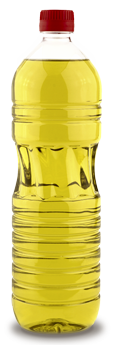

- What are common sources of industrially produced trans fat in cooking and frying?
- How do I choose a soft spreadable margarine, oil or fry product that meets the 2% and 5% trans fat restrictions?
- How long can I use my fry oil for? How do I best maintain it?
- Common questions and answers about restricting trans fat when frying or cooking.
What are common sources of industrially produced trans fat in cooking and frying?
- Fry oils
- Pourable and solid shortenings
- Margarine
How do I choose a soft spreadable margarine, oil or fry product that meets the 2% and 5% trans fat restrictions?
There are a number of alternative products available to help you meet the 2% and 5% restrictions. Click on one of the links below to see alternative options.
- Soft, spreadable margarines
-
All soft ,spreadable margarines must meet the 2% trans fat restrictions. Many non-hydrogenated products are available that are made of palm kernel oil, canola oil, soybean oil, palm oil, and butter. View product list.
-
- Salad dressings, marinades, sautéing, and stir-frying
-
Oils used in salad dressing, marinades, sautéing, and stir-frying must meet the 2% trans fat restriction.
There are many low-stability oils or traditional liquid vegetable oils such as canola, soy, sunflower, and olive oil available to meet your needs. View product list.
-
- Griddle and pan frying
-
Oils used in griddle and pan frying must meet the 2% trans fat restriction.
Shortening used in griddle and pan frying must meet the 5% trans fat restriction.
Liquid Butter Substitutes are commonly used for griddle, grill and pan frying and must meet the trans fat restriction. These are butter-flavoured oils which are much more stable than butter at high heat. View Product List.
-
- Deep-fat frying
-
Oils used in deep-fat frying must meet the 2% trans fat restriction. Shortening used in deep-fat frying must meet the 5% trans fat restriction.
- Occasional deep-fat frying
- If you deep-fat fry occasionally, try a low-stability oil (i.e. traditional liquid vegetable oils such as canola, soy, sunflower, and olive oil).
- However at high heat, low-stability oils can break down quickly, causing excessive oil absorption and off flavours. Change the oil more often than you would for high-stability fry oils or any fry oil containing trans fat.
- Soy and canola oils are often treated to slow the oil breakdown. Additives such as TBHQ and dimethylpolysiloxane make cooking oil more durable for restaurant use and may hold up longer in the deep fryer. You can also extend the fry-life of low-stability oil by blending it with a small quantity of high-stability oil. Talk to your supplier distributor about methods.
- View product list.
- See Guidelines on Deep Fryers and Frying Oil.
- Extended deep-fat frying
- If you fry throughout the day, you need to use a mid or high-stability oil that is stable and slow to breakdown. These function in the fryer the same as partially hydrogenated vegetable oils/shortenings, and some seem to last even longer.
- High-stability oils typically cost more per gallon than low or mid-stability oils. Because they last longer in the fryer, you may find that they are cost-neutral.
- See Guidelines on Deep Fryers and Frying Oil. There are several choices for mid or high-stability oils for extended deep-fat frying:
- Naturally stable plant oils. These include cottonseed, peanut, corn, and palm. Corn and peanut are traditional favourites for extended frying. Palm oil is stable but very high in saturated fat. It should be used sparingly.
- Modified composition oils. "Low linolenic," "mid oleic," and "high oleic" are terms used to describe newer oils that are very stable and good for extended deep frying. These oils come from plant sources (mainly soy, canola and sunflower) that have been bred for this purpose.
- Oil blends. A blend of mid-stability oils and naturally stable plant oil or modified composition oil can increase the stability of the product.
- View product list.
- See Guidelines on Deep Fryers and Frying Oil.
- If you were using a higher trans fat oil to deep-fat fry, you will find that the lower trans fat oil or shortening that you switch to may need more attention.
-
How long can I use my fry oil for? How do I best maintain it?
Every fry product has an approximate “fry life” that varies with the type of frying you are doing. Using any oil past its “fry life” creates unhealthy by-products. When deep-fat frying, careful monitoring and attention is required. Change the oil as soon as it starts to break down. Here is what to look for:
- Excessive darkening, foaming, and thickness (viscosity)
- Smoking
- “Off” flavour and odour in fried food
- Greasiness/loss of crispness in fried food
The signs of oil breakdown are the same no matter what kind of oil you fry in. Abusing or over-using fry oil will lead to soggy, bad tasting and unhealthy food. Good fry oil maintenance is a good business practice that customers will notice.
Click here for Guidelines on Deep Fryers and Frying Oil.
Source: The content on this page was adapted with permission from the New York City Trans Fat Help Center.


